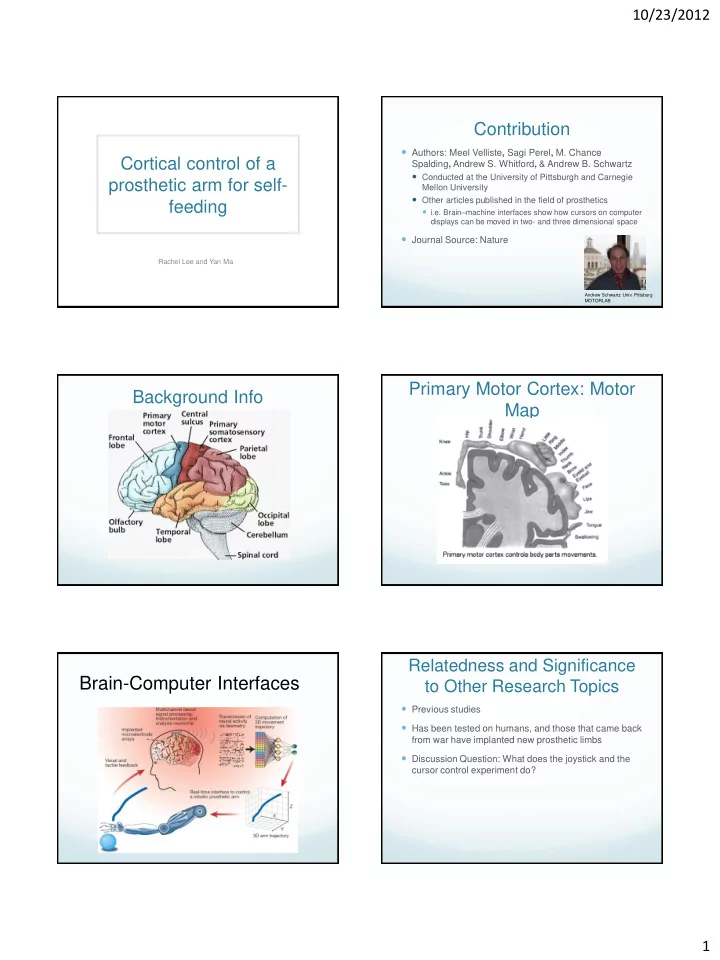

10/23/2012 Contribution Authors: Meel Velliste , Sagi Perel , M. Chance Cortical control of a Spalding , Andrew S. Whitford , & Andrew B. Schwartz Conducted at the University of Pittsburgh and Carnegie prosthetic arm for self- Mellon University Other articles published in the field of prosthetics feeding i.e. Brain – machine interfaces show how cursors on computer displays can be moved in two- and three dimensional space Journal Source: Nature Rachel Lee and Yan Ma Andrew Schwartz Univ. Pittsburg MOTORLAB Primary Motor Cortex: Motor Background Info Map Relatedness and Significance Brain-Computer Interfaces to Other Research Topics Previous studies Has been tested on humans, and those that came back from war have implanted new prosthetic limbs Discussion Question: What does the joystick and the cursor control experiment do? 1
10/23/2012 Cursor Experiment Joystick Experiment 4-D Purpose To demonstrate use of cortical What is the added component signals to control a multi-jointed to the experiment that makes it prosthetic device for direct real- 4-D? time interaction with the physical environment Methods Intracortical microelectrodes were Observation-based training implanted in the proximal arm region of the primary Open-loop cortical control vs. Closed-loop cortical motor cortex. Spike signals controls contribute to algorithm were acquired using a 96- Use of 4-dimensional anthropomorphic arm in everyday channel Plexon MAP tasks (self-feeding) system (Plexon Inc., Dallas, TX, USA). 2
10/23/2012 Video Discussion http://www.nature.com/nature/journal/v453/n7198/suppi How is the prosthetic arm controlled by the monkey’s nfo/nature06996.html cortical signals in the primary motor cortex? Does the monkey’s actual arm respond to the signal as well? (V1) • What are the differences between Monkey A and P? • How did the tests for Monkey A and P differ? Why was Monkey P's success rate higher? Figure 1 Figure 2 (continued) Figure 2 3
10/23/2012 Figure 4 Figure 3 Reiteration of Research Connection between brain computer interfaces and neuroprosthetic implants Science is evolving! Progression from 1-D to 4-D (addition of gripper component) Weakness: 2 subjects tested Strength: Calibration before Tests (control of variables) Figure 4 (Continued) Further Questions Bibliography Some things to think about: http://www.ncbi.nlm.nih.gov/pmc/articles/PMC2972680/ http://www.plexon.com/product/Plextrode___Floating_Microelectrode_Array.html Electrode failure to conduct movement in prosthetic limbs over time http://www.edoctoronline.com/media/19/photos_1ED5955B-D892-4FC4-A189- 68E209191EC6.gif Full motor control of prosthetics in future? http://www.thebigview.com/mind/brain-motor-cortex.gif How do electrode implantation in humans work? http://www.sciencemag.org/content/296/5574/1829/suppl/DC1 http://biomedicalcomputationreview.org/sites/default/files/u6/the-dawn-3.png http://en.wikipedia.org/wiki/Brain%E2%80%93computer_interface http://www.sciencemag.org/content/296/5574/1829/suppl/DC1 Special thanks to Dr. Carl 4
10/23/2012 Additional Videos http://www.nature.com/nature/journal/v453/n7198/suppi nfo/nature06996.html 5
Recommend
More recommend